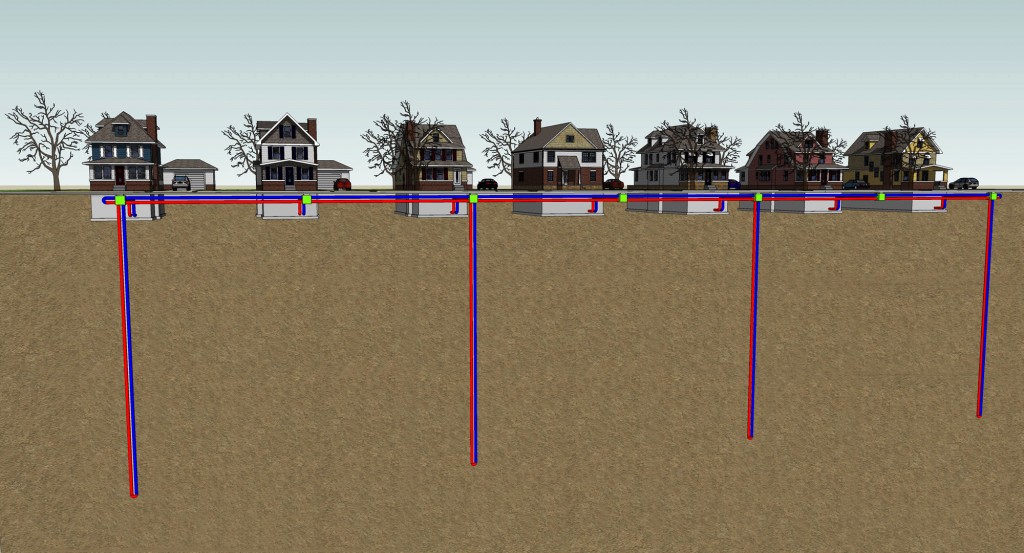

The Town of New Paltz may soon be among several local municipalities and developers to invest in an alternative energy source for homes and businesses.
After a proposal was made by the Midwestern company Hardin Geothermal to Town Board members in December, New Paltz Town Supervisor Toni Hokanson signed a notice of intent that could spearhead a wide-scale installation of geothermal heating and cooling systems to town residents.
Besides providing a cleaner, greener way to produce energy, Hokanson said the new systems and public-private partnership with the company could generate a permanent revenue stream for the town. It could also save money for homeowners.
“The payment to both the town and the company would be less than what people are currently paying for oil and natural gas,” Hokanson said. “In this economy right now, anything we can do to help cut people’s heating costs so it’s more affordable for them to live is something we definitely have to explore.”
According to Larry Steel, a sales representative for Hardin Geothermal, the initial stages of the project could cost up to $20 million and are broken down as follows:
• $1 million for engineering services
• $9 million for “Geo Field”
• $7 million for interior equipment for homes
• $3 million for interior equipment for businesses
In order to meet this quota, Steel said the company is actively looking for grant money from contacts such as the United States Department of Energy and the New York State Energy Research and Development Authority (NYSERDA). Meetings have also been held with administrators from SUNY New Paltz, the New Paltz Central School District and the developer of the upcoming New Paltz Hampton Inn.
“We’re just trying to meet with them and gauge their level of interest,” said Steel. “From the underwriters’ point of view, if we can get anchor tenants into geothermal utility early then it’s going to make them feel a lot more comfortable about structuring the financing.”
Among the several applications used for geothermal energy production worldwide, Steel said the standard method that may be used in New Paltz requires a “closed-loop” system.
According to Steel, this system would extract heat from water below the planet’s frost line, which maintains a temperature of about 51 degrees because of stored solar energy. Using the water’s temperature as a starting point, a heating, ventilation and air conditioning (HVAC) system evenly distributes warm air into a building. In the summer, the system reverses itself and propagates cool air utilizing the same method.
This method is deemed as “closed-loop” because no water is re-injected.
“[The water] is just circulated within a pipe, then through the ground source feed pump, then through the building and then back into the ground,” Steel said. “There’s no environmental impact at all and it’s constantly recharging the ground.”
Steel said this process is cheaper and 40 to 70 percent more energy efficient than conventional air conditioning and heating systems, which use outside air often subject to extreme temperatures.
According to Alvin Konigsberg, professor of geology at SUNY New Paltz, the method for heating and cooling homes and businesses proposed by Hardin Geothermal has many benefits. However, he said if the public wants to have less of an environmental impact, they don’t necessarily need to convert to a geothermal system. They need to instead ask themselves whether central air conditioning is essential to them.
“I can put in a gas fire heating system for a lot less money, that is slightly less efficient and heat my house in the winter and just cool it with fans during the summer,” Konigsberg said. “Environmentally, I’d probably have less impact. Everybody’s got to have heating but not everybody has to have air conditioning.”
Hokanson said the geothermal utility systems could also be available for village residents and businesses if a method is created to purchase services through the town. Alternatively, the village government could also choose to create a partnership with Hardin Geothermal.
If SUNY New Paltz were to also align with the company, Hokanson said results could be prosperous for the campus.
“It could potentially be huge savings for [SUNY],” she said. “I don’t know what the heating and cooling costs are there, but that way the college isn’t putting out the initial money for construction.”
While drilling for the geothermal project is not estimated to begin for at least a year, Hokanson said she has been looking for other ways to provide savings for the town.
Currently, she said she is working with NYSERDA and Central Hudson to have inefficient light fixtures in municipalities swapped at no cost. These new fixtures are part of a plan to cut down on the electricity bill in the budget line by next year.
“The only way to make a difference is to keep chipping away from different angles,” she said. “The longer you put off starting things, the longer you put off seeing a benefit.”
